The best winter hiking boots: for unbeatable performance in the cold
Our selection of the best winter hiking boots, essential for venturing into the mountains on sub-zero adventures

Selecting the best winter hiking boots for your sub-zero adventures is a big consideration, especially as premium boots like these come with a serious price tag. However, winter conditions in the mountains should never be taken lightly. Every penny you spend on a pair of winter boots is worth it for your safety, comfort and enjoyment during the most challenging, yet most rewarding, time of the year.
The best winter hiking boots are truly versatile, able to take on dry trails, soft snow, frozen neve and iced up rock. They are designed to fit a compatible crampon, while all are designed to keep your feet as warm and dry as possible.
The old cliche goes that the Eskimos have 50 words for describing different varieties of snow. The best winter hiking boots have to be able to cope with all of them, so it's no wonder that they are, in many ways, the best of the best hiking boots. Of course, they're a little heavy and warm for use in warm summer conditions but many of the lighter models are great for the shoulder seasons too.
In this guide, we feature B2 (four-season) boots, perfect for low grade mountaineering when combined with a C2 crampon, and B1 (three- to four-season) boots, which can be combined with C1 crampons for winter walking.
The best B2 boots
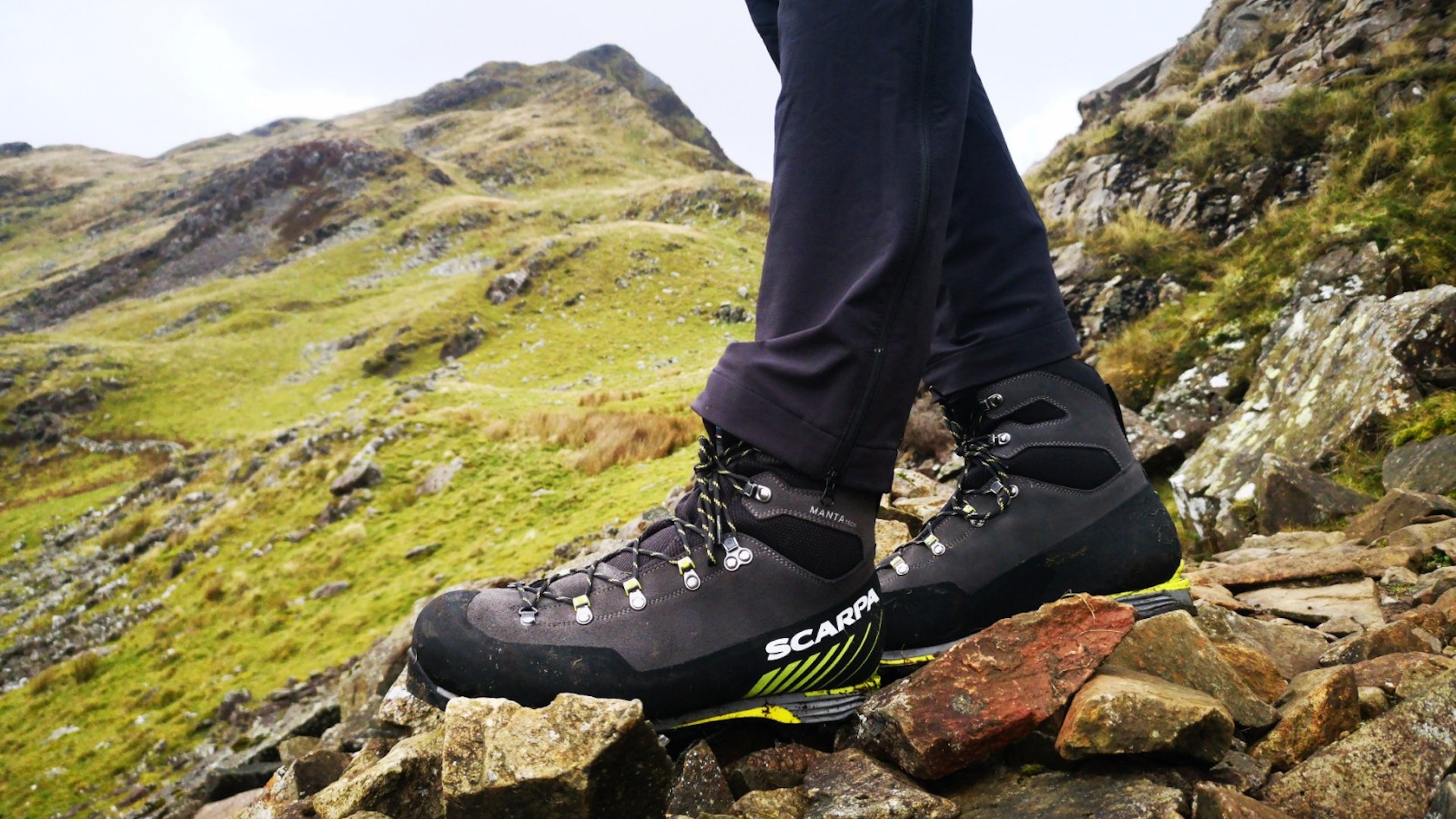
Specifications
Reasons to buy
Reasons to avoid
Frequently referred to as the “benchmark” four-season mountaineering boot, the Scarpa Manta is a perennial favorite among a host of outdoor professionals, from mountain rescue team members to winter skills course instructors. This latest version, called the Manta Tech, is the replacement for the old Manta Pro boot, many of which are still going strong despite being used and abused over multiple winter seasons.
The Manta Tech is built on the same last as the previous Manta Pro but has a cleaner, more streamlined look thanks to redesigned uppers. As well as giving the boot a more modern and stylish appearance, this should also be a plus for durability, since there are now fewer panels and reduced stitching. The wraparound rubber rand has also been replaced with a partial TPU rand, which cuts weight. It’s still no lightweight, but then this is a boot built for hard winter mountain use. As such, the insulation has also been beefed up for colder conditions.
The outsole is the reliable and durable Vibram Pentax Precision XT unit, made from a particularly durable compound. The lug pattern features a front climbing zone for precise edging. If and when you encounter ice and hard-packed snow, the boot is flat lasted and equipped with a heel welt for an optimal fit with C2 crampons. It really does come into its own with a semi-auto crampon fitted, with no slippage and a very sturdy, secure feel underfoot.
These are boot for tackling tough terrain in cold conditions, and for that sort of stuff the Scarpa Manta Tech GTX are just about the best winter hiking boots on the market.
Read our full Scarpa Manta Tech GTX review

Specifications
Reasons to buy
Reasons to avoid
When it comes to serious mountain boots, La Sportiva’s Trango series is one of the most famous names in the game. Today, there is a whole raft of boots in the Trango line-up. The Tower sits comfortably in the middle of the range, being more technically capable than the hike and trek-focused Trango Tech or Trango Trek, and just below the “big mountain”-oriented Trango Cube or Trango Tower Extreme. However, the Trango Tower has a little more flex than either of the two latter models, making for a much more versatile and forgiving boot overall, which is why we’ve selected as as one of our best winter walking boots.
This is a B2-rated boot, which means it is compatible with a C2 semi-automatic crampon. That’s an ideal combo for taking on graded winter mountaineering routes. Despite offering a stiff and stable platform for crampons however, it is not so rigid that you can’t also wear them for general hillwalking and scrambling.
The uppers are synthetic rather than leather, which may put traditionalists off. But remember that this saves a fair bit of weight, makes them arguably easier to look after and means they don’t absorb water either.
Performance is as good as anything else out there in its class, particularly when it comes to traction and precision underfoot. La Sportiva’s Cube outsole is exclusively made for them by Vibram. It sticks to rock impressively well, providing reassuring grip and strong edging capability. The one downside is that it is known to wear quickly. However, the Trango Tower is resoleable, which is likely to cost you about $100 / £85 – not cheap, but less than a third of the cost of a new pair.
Read our full La Sportiva Trango Tower GTX hiking boots review

Specifications
Reasons to buy
Reasons to avoid
This solid and robust boot from renowned German bootmaker Meindl is a classic all-season hillwalking boot. It’s stiff enough to take a C2 crampon in winter, yet still extremely comfortable over longer distances. That’s largely thanks to Meindl’s excellent Comfort Fit last, which is particularly well suited to walkers with broad feet, as it has a wide forefoot and a very roomy toebox.
Uppers are made from high-quality suede leather, with flexible mesh panels, a Gore-Tex lining and a full rubber rand. There’s plenty of cushioning around the tongue and ankle cuff too, as well as underfoot thanks to a spongy EVA insert embedded in the midsole and a cosy, fleece-lined footbed. It all makes for a wonderfully forgiving feel that is well suited to long, loping mountain days in all weathers, even with snow and ice on the ground.
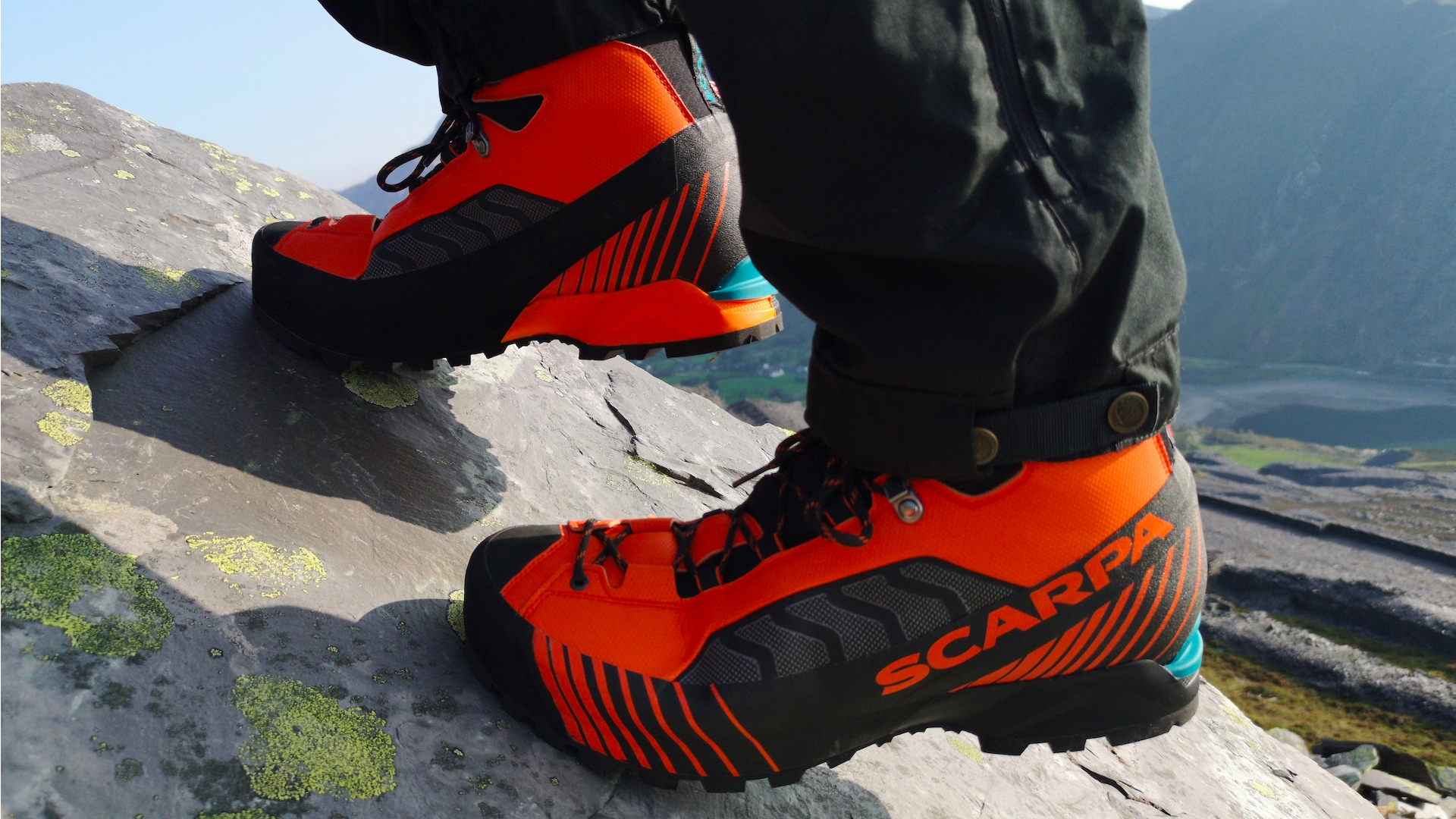
Specifications
Reasons to buy
Reasons to avoid
The Ribelle Lite is a very lightweight technical boot designed for mixed mountain walks and scrambles. It has a stiffened midsole and a heel welt for use with C2 crampons, making it suitable for winter use. However, it’s also designed with a noticeable toe spring for easier walking on gentler slopes and undulating ridge lines.
It’s a slightly unusual boot in terms of both fit and construction, but we found them very comfortable on test, being particularly won over by Scarpa’s Sockfit softshell tongue. The uppers also seem to be pretty tough for a synthetic boot, with minimal stitching and a wraparound rand promising good durability. We can see that this isn’t a boot that will necessarily suit all users – but if you’re looking for a capable yet versatile mountain boot without that big, clumpy feel, these might be just what you’re searching for.

Specifications
Reasons to buy
Reasons to avoid
The Crow GTX is the least expensive of Salewa’s technical mountain boots, but it’s a capable boot with a stiffened midsole and a rear heel welt that means it will take a C2 crampon. The Crow GTX employs many of the same Salewa technologies that characterise the brand’s higher-level offerings, including the unique 3F System, an external steel cable that wraps around the heel section and connects with the lace hook at the base of the ankle.
This helps to pull the boot in tightly when laced, improving all-round ankle and heel support. The boot also features a climbing-inspired to-toe lacing system for enhanced precision and a close fit. Lastly, a softshell Flex Collar at the rear of the ankle collar relieves pressure on the Achilles for increased comfort during descents. Uppers are mainly made from an abrasion-resistant textured fabric, though there are some suede panels around the toecap, laces and tongue. You also get a full rand for all-round protection. While this construction is likely to be slightly less durable than an all-leather boot, it does reduce the weight and cost. And it’s still fairly tough, providing decent protection for the foot, whilst fending off rock and scree.
A Gore-Tex Performance Comfort lining also ensures the boot delivers fully waterproof protection and breathability in wet conditions. This versatile mountaineering boot undercuts most of its rivals when it comes to price, but delivers in terms of performance too, offering B2 stiffness in a lightweight and precise package. If you prefer a close-fitting boot with plenty of feel underfoot, these are a great pick.

Specifications
Reasons to buy
Reasons to avoid
When reviewing boots, outdoor kit reviewers often talk about factors like grip, stability, support and even that nebulous thing called “feel”. Those are all important, but ultimately, much of what makes the best winter hiking boots comes down to whether they inspires confidence. Basically, the underlying question is this: can you trust your next step?
With the Asolo Piz, the answer is a resounding yes. These boots are neat and nimble, lightweight and precise, with reliable traction underfoot – all qualities that are likely to make you regard the knife-edge ridge snaking out in front of you with a sense of excitement and anticipation rather than fear and apprehension.
When it comes to fit, they have a slim heel and midfoot, with a slightly asymmetric toe-box that isn’t dissimilar to the shape of a trad climber’s rock boot. The Vibram Mulaz outsole also delivers contact grip via a front ‘climbing zone’ for precise foot placement on smaller ledges. But it also performs well on mixed terrain, whether you’re moving uphill, downhill or traversing along angled slopes.
The uppers are made from suede leather and Schoeller softshell fabric with a waterproof and breathable Gore-Tex Performance Comfort lining. They have a full wraparound rand with a protective toecap, plus a heel welt to take a semi-automatic C2 crampon. They’re certainly stiff enough to work well in full winter conditions. Unlike most other stiffened mountain boots, however, these have a more structured insole, which means they don’t feel too board-like, and even deliver a bit of welcome arch support.
Read our full Asolo Piz GV winter hiking boot review
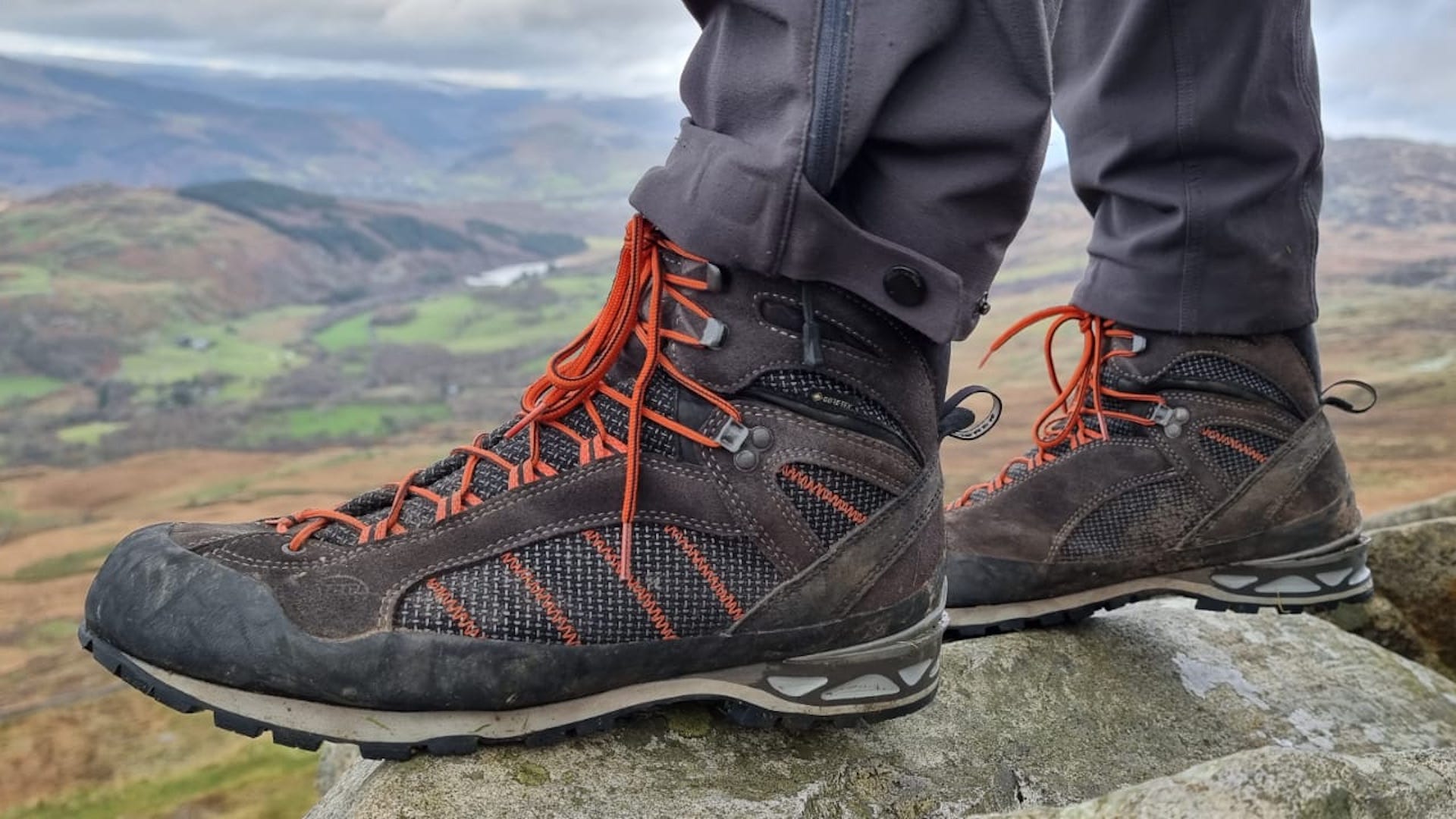
Specifications
Reasons to buy
Reasons to avoid
The Makra Combi GTX from German bootmaker Hanwag is very comfortable and exceptionally light for a “proper” mountain boot. In fact, despite its beefy looks, it’s the lightest of all the boots we tested in this best winter hiking boots buying guide. Its low weight is down to the use of suede and Cordura fabric uppers and a special honeycomb sole structure.
The great out-of-the-box comfort comes from a wonderfully soft, supple ankle cuff and a generously padded tongue, as well as the fact that it is built on Hanwag’s Wide Alpine last. This results in a slightly broader forefoot to prevent pressure points when hiking or climbing. It also means you can wear thicker socks to keep feet warmer in winter conditions, which partly offsets the boots’ lack of insulation.
As such, it’s a boot that is suitable for four-season use, with a rear heel welt to take a semi-automatic C2 crampon. And despite the use of lightweight materials, it’s still durable enough for rock, snow and ice. Those Cordura panels proved plenty tough enough on test, while an all-around rand also gives added protection.
All in all, the Makra Combi is a capable rock-hopper with the added ability to handle snow and ice, since the midsole is stiff enough to provide a stable platform on frozen terrain. Just wear your chunkiest mountaineering socks to ward off the cold, and perhaps consider adding an aftermarket insole if you like extra cushioning and arch support underfoot (see: Hiking insoles: what they are and why you need them).
Read our full Hanwag Makra Combi GTX hiking boots review
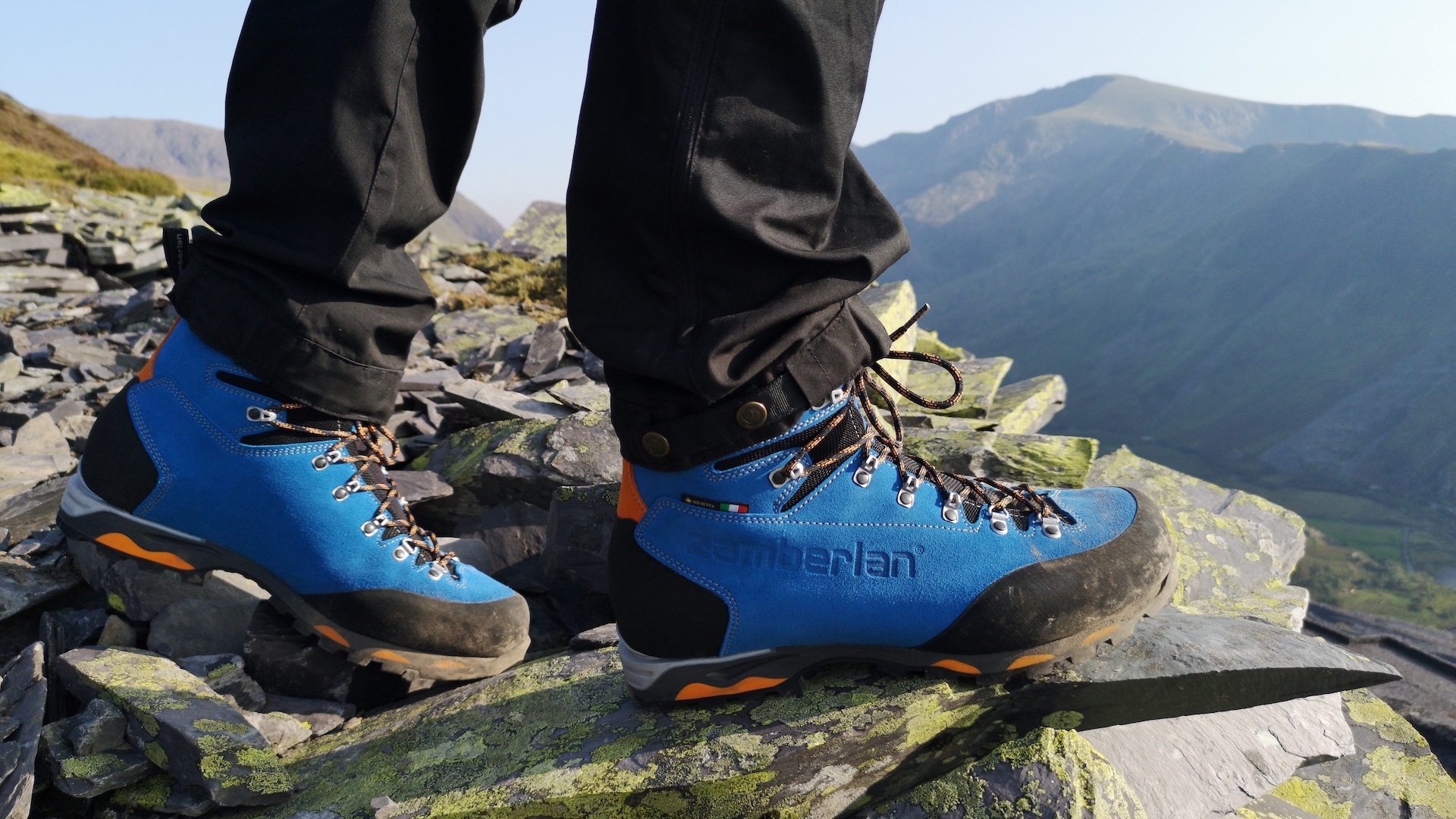
Specifications
Reasons to buy
Reasons to avoid
Zamberlan is an Italian bootmaker with serious heritage and a stellar reputation for turning out sturdy, handsome footwear that is built to last. That’s why the brand’s traditionally stylish 996 Vioz GTX boots are our current pick as “best waterproof hiking boot’” in our best all-round hiking boots selection. But if you’re looking for an even tougher Alpine trekking boot with the ability to fit a crampon, then the Baltoro 1000 might be an even better choice.
This model features a stiffened midsole and a heel welt, which means it can be fitted with semi-automatic (C2) crampons for winter use. Although it’s really designed for Alpine trekking, the Baltoro also works well for adventures elsewhere, including UK destinations like the Scottish Highlands and Islands, Snowdonia in North Wales or the English Lake District.
The padded tongue and high ankle cuff are faced with tough Cordura nylon fabric, as is the insert at the top of the foot, which enables some ankle flex. That high cuff offers plenty of support – ideal when crossing broken ground or traversing steep slopes, even in snow. The Vibram Mulaz outsole is a proven pattern that offers good traction thanks to well-spaced lugs and a pronounced heel brake, with a front climbing zone designed to help when edging on rock.
Read our full Zamberlan 1000 Baltoro winter hiking boots review
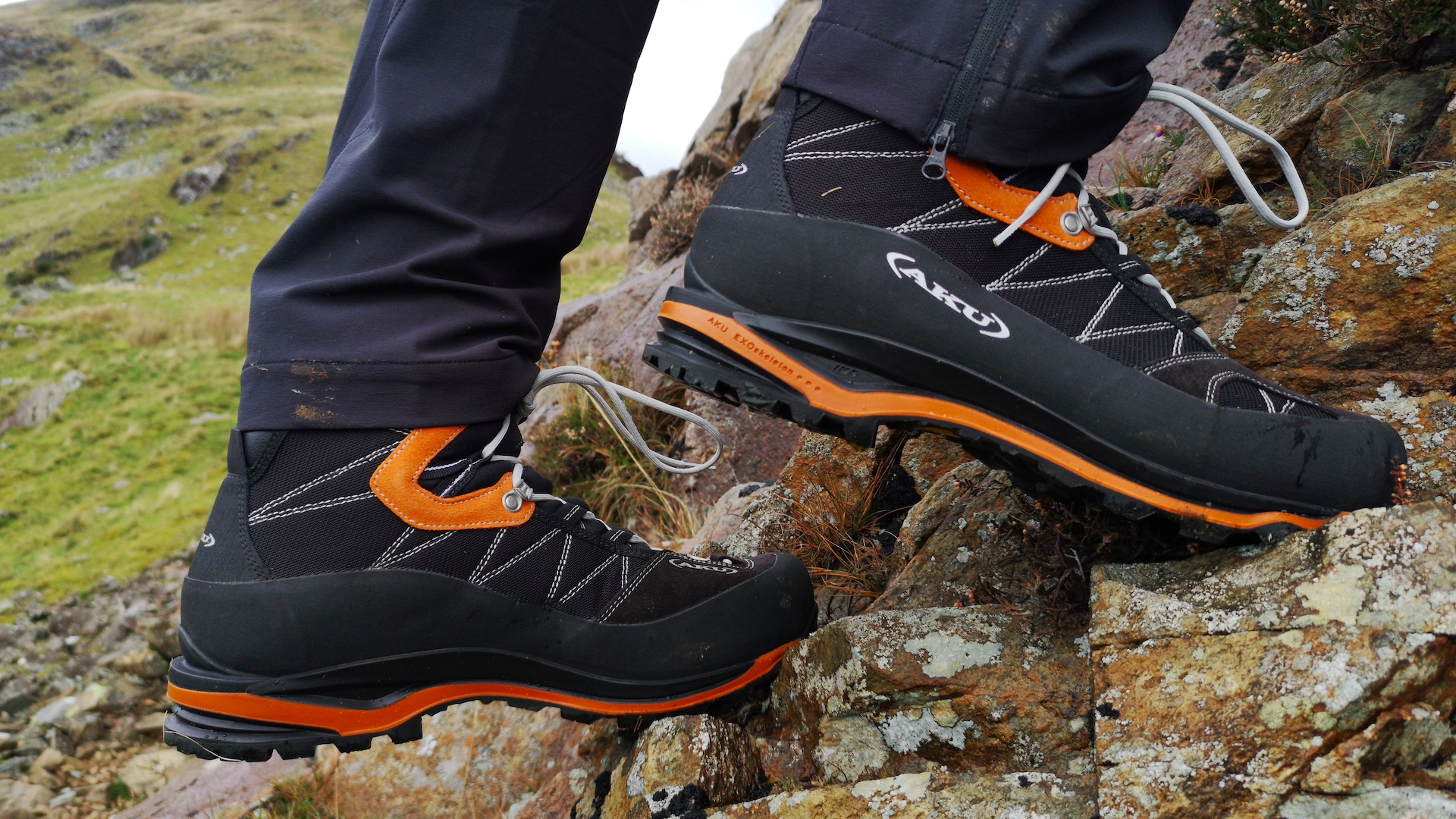
Specifications
Reasons to buy
Reasons to avoid
On paper, the AKU Tengu tick virtually all the boxes when it comes to the best winter walking boots. The design incorporates a high-ankle cuff for plenty of support and protection, tough uppers with a wraparound rand for durability, a Gore-Tex lining for reliable waterproofing, and a Vibram sole for reliable traction underfoot.
Actually, there’s even more to the boot than that – it’s just that most of the really clever stuff is hidden from view. Structurally, the boot is made up of a dual-density PU midsole with a carbon fiber shank. This consists of a durable “Exoskeleton’”along with a lightweight inner section for better cushioning. As a result, they feel supportive yet comfortable, being stiff enough to take a C2 crampon and climb competently, yet with enough cushioning for easy walking. The burly toe box is equally good for scrambling or kicking steps in snow.
AKU boots are generally known for their excellence in terms of fit, with sophisticated tech and lasting to try and guarantee a close, precise fit. Indeed, some reviewers have praised the Tengu in this regard. Unfortunately, we didn’t get on quite so well with it, experiencing noticeable heel slip no matter how tightly we laced the boots. Even trying a thicker insole didn’t help. It’s a minor niggle though, and one that may not affect all foot shapes and volumes. Just because it didn’t suit us doesn’t necessarily mean it won’t suit you.
Read our full AKU Tengu GTX winter hiking boots review
B1 boots for three- to four-season hiking

Specifications
Reasons to buy
Reasons to avoid
The Meindl Air Revolution 4.1 is a gear all-rounder. Rather than being full-grain leather, the uppers are made from suede leather and mesh, with a Gore-Tex lining. This saves considerable weight while also making for a more breathable construction. In fact, Meindl have put a lot of thought into keeping your feet cool in these boots. They employ the brand’s Air Revolution technology, with a clever dual-layer tongue that incorporates ventilation channels to circulate cool air into the boot and pump out warm, moist air. The idea is to keep your feet drier and more comfortable across a wider temperature range.
Despite the hillwalking-focused design, however, they still boast many of the features associated with mountaineering boots. This includes lacing that extends almost to the toe, a wraparound rand, a Vibram Alpin Rigid outsole and a midsole with a PU wedge and integrated heel welt. This means the boot isn’t quite as stiff as those with a full-length or three-quarter length shank but is still suitable for occasional crampon use. Thanks to that heel welt it is even compatible with a C2 crampon.
We’d recommend these if you’re a year-round hillwalker who likes to take the odd summer trip to tackle higher alpine regions. They can certainly tackle icy or snowy sections of an alpine trek, and can also cope with frozen fells or the less demanding winter peaks. Basically, if you carry 10-point crampons and a straight piolet-style ice axe, the Air Revolution 4.1 will be the boot for you. For anything more technical, you might want a slightly more capable boot (perhaps the Meindl Himalaya or Jorasse, for example).
Read our full Meindl Air Revolution 4.1 hiking boots review

Specifications
Reasons to buy
Reasons to avoid
The word “workhorse” was pretty much invented for products like the Lowa Cevedale Evo GTX. It sums up these boots perfectly. They are robust, protective and supportive – no surprise then that this model is the German brand’s most enduring and popular mountaineering boot. The uppers are made from chunky suede leather, with a high wraparound rand. They are backed with a Gore-Tex liner for reliable waterproofing. This belt-and-braces construction also means that although they are not insulated, they are still warm enough for winter conditions.
The midsole is stiff enough to perform competently on snow and ice too, with a heel welt for a C2 crampon and a full-length nylon shank. A rigid toe box also means you can happily kick steps in steep snow. But despite these capabilities, we still wouldn’t describe them as a full-on mountaineering boot – rather, we’d say they sit somewhere between that and a heavy hiking boot. The reason for that is that the sole unit has a slight rocker and that nylon shank has enough spring to accommodate a natural walking action. The Vibram sole offers good traction on varied surfaces, although there is also a front contact zone for scrambling on rock. You also get plenty of padding around the ankle cuff for enhanced comfort, with a slight rear cutaway that helps to reduce pressure on the Achilles.
Negatives were minor. If we were being critical, we could point to the thinner sole unit, which isn’t the most forgiving underfoot. The flat-lasted construction also means that the fit is not quite as refined as the more precise, anatomically sculpted lasting of some other boots.
Read our full Lowa Cevedale Evo GTX hiking boots review
Boots | RRP | Weight | Rating |
Scarpa Manta Tech GTX | £300 (UK) / €355 (EU) | 880g / 1lb 15oz | B2 - Four-season boot |
La Sportiva Trango Tower GTX | £300 (UK) / €270 (EU) | 745g / 1lb 10oz | B2 - Four-season boot |
Meindl Antelao Pro GTX boot | $350 (US)/ £295 (UK) | 970g/2lb 2oz (size UK 12/US 13) | B2 - Four-season boot |
Scarpa Ribelle Lite HD boot | $340 (US)/ £290 (UK) | 771g/1lb 11oz (size UK 12/EU 47/ US 13) | B2 - Four-season boot |
Salewa Crow GTX boot | $290 (US)/ £220 (UK) | 860g/1lb 14oz (size UK 12/US 13) | B2 - Four-season boot |
Asolo Piz GV | £263 (UK) / €287 (EU) | 640g / 1 lb 6.6oz | B2 - Four-season boot |
Hanwag Makra Combi GTX | £240 (UK) / €270 (EU) | 625g / 1lb 6oz | B2 - Four-season boot |
Zamberlan Baltoro 1000 GTX | $325 (US) / £230 (UK) / €279 (EU) | 800g / 1lb 12oz | B2 - Four-season boot |
AKU Tengu GTX | £290 (UK) / €340 (EU) | 725g / 1lb 9oz | B2 - Four-season boot |
Meindl Air Revolution 4.1 | £282.50 (UK) / €330 (EU) | 700g / 1lb 8.7oz | B1 - Three- to four-season boot |
Lowa Cevedale Evo GTX | $360 (US) / £285 (UK) / €335 (EU) | 825g / 1lb 13oz | B1 - Three- to four-season boot |
How to choose the best winter hiking boots

Stable and supportive boots are essential if you’re venturing into more technical terrain in winter conditions. The same applies if you’re trekking in high-alpine areas with exposed rock, snow and ice.
In addition to the comfort and grip that you want from virtually all outdoor footwear, you’ll need a boot with a stiffened sole suitable for fixing a crampon, along with some insulation for warmth, a high ankle cuff and a wraparound rand for increased foot protection.
In the following overview, you'll come across a few terms that you might not be familiar with. If you're in need of a jargon buster, check out our explainer on the parts of a hiking boot.
Fit and comfort
You can trust Advnture
A well-chosen pair of men’s winter hiking boots should last several years. When it comes to the best boots, comfort is just as important as performance, so you actively look forward to getting out into the mountains. Poor-fitting boots can cause blisters, coldness, toe injuries, general discomfort and even accidents, all of which will discourage you from going hillwalking again. Of course, you should always take time to break in boots after purchasing them.
All brands have their eccentricities – such as a tight toe box – and some tend towards being larger or smaller than you might expect for the size, so try before you buy if possible. Factor in the need for a good hiking sock too – our guide to the best hiking socks you can buy will point you in the right direction.
Weight
Although weight is always a consideration with outdoor kit, more extreme conditions and technical terrain will inevitably demand sturdier and therefore heavier hiking boots. Having said that, mountaineering boots are getting lighter all the time without compromising on performance, thanks in part to advances in materials and construction methods, as well as a gradual change in ethos. The rise of “Alpine-style’” mountaineering and climbing, or alpinism, which espouses a fast-and-light approach, has encouraged gear manufacturers to prioritize low weight as a critical factor in boot design.

Support
The tougher the terrain, the greater level of protection and support you’ll require. If you’re tackling exposed rock, scree, snow and ice, you will need more support and rigidity to help with steeper ground, prevent the likelihood of slippage and ankle injury, and provide more protection.
In addition, winter adventures in the hills and mountains generally means carrying more gear, in the form of extra clothing and safety equipment – which may include crampons, a rope, an ice axe, a mountaineering rack, climbing harness, climbing helmet and other hardware. This means a bigger pack (typically around 45 litres even for a single day route) and a heavier load.
This is likely to affect your balance and natural stability, further increasing the need for more supportive boots and good grip. They are essential for traversing technical terrain.
Price
Unfortunately, there’s no real way of getting around the fact that serious kit usually costs serious money. But it helps to think of a good pair of winter boots as an investment. If you look after them, you ought to get several seasons’ use out of them – so in that sense, investing time and some hard-earned cash on quality boots ought to offer plenty of value for money. From a safety perspective, you’d also be daft to compromise your own wellbeing in the mountains for the sake of saving a few bucks.
Of course, we appreciate that there’s a limit to everyone’s budget, so we’ve selected the best winter hiking boots at a range of different price points. And if you’re really strapped for cash, look out for the chance to make big savings in seasonal sales, shop smart by taking advantage of discount codes and offers, ask retailers to price-match, or consider buying used equipment. Though the thought of buying someone else’s boots might not appeal, since fit is unique from person to person, it’s not uncommon to find barely-worn boots being sold by people who have discovered that a specific boot isn’t quite the right size or fit for their feet – slightly too broad in the midfoot perhaps, or too narrow in the toebox, or with too much volume overall (space in the boot). Conversely, that might mean they’re the perfect fit for you.

Seasonality
All-round hiking boots are often referred to as “three-season” boots, which means they’re suitable for use from spring through to fall. When winter rolls around though, if you’re venturing into mountainous terrain, you will almost certainly need a true “four-season” boot. This designation implies they are suitable for winter hillwalking and mountaineering.
The major difference between a three-season boot and a four-season boot – aside from general toughness – is the stiffness of the sole. Four-season boots have a rigid shank embedded in the midsole, which stiffens the boot both longitudinally and torsionally (ie, from toe to heel and from edge to edge), preventing it from flexing or bending too much in either direction. As well as providing increased stability on uneven terrain, this also ensures the boot can be safely used with a crampon.
Crampon-compatible boots are usually rated either B1, B2 or B3. Similarly, crampons are usually classed with a matching C1, C2 or C3 system. So, a C1 crampon is best used with a B1 boot, a C2 crampon with a B2 boot and so on. Having said that, you can match a B2 boot with a C1 crampon, but not the other way around. Here’s why:
A B1 boot has a stiffened midsole with a half or three-quarter length shank to accommodate a flexible C1 “hillwalking’”or “glacier walking” crampon. These have step-in bindings and (usually) 10 points.
A B2 boot has a fully stiffened midsole with a full-length shank. In addition, it has a noticeable heel welt (a pronounced ledge at the heel of the boot) to fit a C2 semi-automatic crampon. This is a crampon with a rear binding fitted with a clip or lever, and a flexible basket at the toe. C2 crampons are usually fitted with 12 points.
A B3 boot is a true mountaineering boot with a full-length shank. They are usually too rigid to walk comfortably below the snowline. They have a heel welt and a toe welt to accommodate a fully automatic C3 crampon, which has heel and toe slips. A C3 crampon usually has 12 or 14 points, and may have modular front points that can be switched from dual points to monopoints for tackling challenging ice climbs.
All the boots featured here are either B1 or B2-rated.
What to do with your old winter hiking boots
If you're upgrading your winter hiking boots and your old ones are still in reasonably condition, you can donate them to a charity shop, thrift store, or local outdoor gear exchange. Have a look online and make sure they're interested in receiving footwear before making a journey.
If your old boots aren't in good enough condition to donate, and they can't be resoled so you can keep using them a little longer (see should I resole my hiking boots for details), you still have a few options.
Many household waste recycling centers will accept shoes and boots, and will send them to specialist facilities for processing. If you have a lot of footwear, or you can organize a drive with friends or colleagues, you can order a shoes and footwear zero waste box from Terracycle, which will include a shipping label. In the UK, Cotswold Outdoor accepts paired shoes and boots (except for ski boots) in its in-store recycling bins.
All the latest inspiration, tips and guides to help you plan your next Advnture!
An outdoors writer and editor, Matt Jones has been testing kit in the field for nearly a decade. Having worked for both the Ramblers and the Scouts, he knows one or two things about walking and camping, and loves all things adventure, particularly long-distance backpacking, wild camping and climbing mountains – especially in Wales. He’s based in Snowdonia and last year thru-hiked the Cambrian Way, which runs for 298 miles from Cardiff to Conwy, with a total ascent of 73,700 feet – that’s nearly 2½ times the height of Everest. Follow Matt on Instagram and Twitter.

